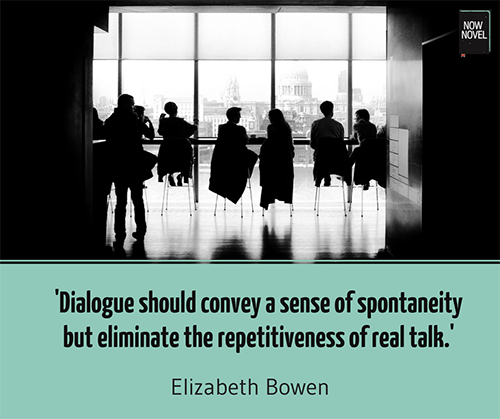Realistic dialogue doesn’t necessarily mimic everyday speech. There’s a lot of real-world filler we remove when writing dialogue (e.g. pleasantries, ‘Fine thanks and you?’) Yet for dialogue to feel real, it’s important to avoid missteps that make dialogue ring hollow:
1: Writing info dumps (the realistic dialogue killer)
Writing an info dump in conversation between characters will make your dialogue seem wooden and posed.
Info dumping in dialogue (also known as the ‘As You Know, Bob’) draws attention to the fact the author is catching the reader up on important plot points. An example of what not to do:
‘As you remember, Peter, we’re being retrenched because robots took our jobs.’
‘Yeah, Jake. I have no idea what I’m going to do now.’
It always seems strange when a character tells another about an event they’re both already aware about. Because it’s clearly for the benefit of our own understanding.
Instead, you can imply this shared knowledge:
‘Pete, did you see them unloading the shipment? Scary looking things. I heard two configured right are all it takes to assemble a unit in three seconds.’
‘We can’t compete with that, Jake. What the heck will we do?’ Peter grimaced.
The second example is less obvious, and avoids info-dumping. Instead of telling us the plot point through dialogue, it shows the characters’ fear and implies the situation (that they will be made redundant because they cannot compete). Instead of giving us the end result immediately, it creates uncertainty, build-up.
To avoid AYKB info dumps, you can:
- Make one character unaware of the development: This creates a character-driven (not reader-driven) reason for sharing the plot point characters discuss
- Turn the dialogue into an argument: Perhaps Peter and Jake disagree about whether or not the robots are a bad idea
Giving characters reason to hold the conversations they have will help you avoid info dumps.
2: Using too many dialogue tags (he said, she said)
Many authors agree that straightforward dialogue tags (such as ‘she said’ or ‘he said’) are preferable to creative tags such as animal sounds (‘growled’, ‘barked’, ‘purred’).
The arguments against describing characers’ speech using exotic tags are:
- They’re often unrealistic: Try to ‘purr’ a line of speech out loud now
- They draw attention to themselves: For realistic dialogue, you don’t want your characters’ words (or the tags that follow) to draw attention to the fact they are dialogue
- Too many dialogue tags distract us from the important information: What is actually said
Having ‘she said’ after every line becomes repetitive and monotonous. For example:
‘Save your breath. You’ll need it on your deathbed,’ she said.
‘I need my breath now,’ Violet replied.
‘Did he move out? Is he with her?’ she asked.
‘No. We still together. She’s dead,’ Violet said.
‘Dead? Then what’s the matter with you?’ the woman asked.
This is an example from Jazz (1992) by Toni Morrison, changed to show the deadening effect of too many dialogue tags.
Now read how Morrison actually writes this snatch of conversation between a beautician and her client about an unfaithful partner:
‘Save your breath. You’ll need it on your deathbed.’
‘I need my breath now.’ Violet tests the hot comb. It scorches a long brown finger on the newspaper.
‘Did he move out? Is he with her?’
‘No. We still together. She’s dead.’
‘Dead? Then what’s the matter with you?’
Through line breaks and an action (Violet testing the comb, which shows the preceding words belong to her), Morrison makes it clear who’s speaking and allows us to focus on the content of Violet and her client’s dialogue.
[Join Now Novel’s 4-week online dialogue-writing course, ‘How to Write Dialogue’, and get four workbooks with exercises, videos, and professional critique to improve your dialogue. Learn more here.]

3: Making characters resemble talking heads
Another common mistake in many dialogue first drafts is characters seeming like disembodied talking heads. It isn’t crucial to have an action or gesture in every line. Yet if throughout a lengthy dialogue there is no sense of your characters’ surrounding environment, we lose a sense of detail; place.
Jerome Stern puts it thus:
Dialogue is not just quotation. It is grimaces, pauses, adjustments of blouse buttons, doodles on a napkin, and crossings of legs.
Here’s an example of realistic dialogue that avoids the ‘talking heads’ problem. In Donna Tartt’s The Goldfinch (2013), her protagonist Theo has survived a public bombing:
‘Were you here when the initial blast occurred?’ Ray said, pointing. ‘Or here?’
‘I don’t know.’
‘Take your time.’
‘I don’t know,’ I repeated, a bit frantically. The diagram of the rooms had a confusing, computer-generated quality, like something from a video game or a reconstruction of Hitler’s bunker that I’d seen on the History Channel, that in truth didn’t make any sense or seem to represent the space as I remembered it.
The character Ray points to a diagram, and mid-conversation Tartt’s protagonist Theo breaks off to reflect on it.
The dialogue leads outward into the action and setting of the scene, thus it feels anchored in a believable process (the investigation into the blast).
As Tartt does, punctuate dialogue where relevant with gesture, with actions involving your characters’ surrounds, and their private thoughts. Although in real life conversation we might not know what two people are secretly thinking, narrating characters’ private thoughts in dialogue adds a stronger sense of their reality. It allows us to know many things unsaid along with everything said.
4: Making characters’ voices too similar
Another pitfall when writing dialogue is making characters’ voices too similar.
It’s not always possible or necessary to make differences between characters’ voices striking and emphatic. In a passing conversation about a minor plot point, or a brief exchange, differences might not always come to the fore. Yet over the course of your novel, if you tell characters’ voices apart, according to their individual personalities, their voices will ring true.
The Victorian author Charles Dickens is a master of characterization. Dickens excels at giving characters individual quirks and features that make them stand out.
For example, Dickens’ Great Expectations (1861) opens with protagonist Pip being surprised in a church graveyard by an escaped convict in hiding. Here is some of their exchange. Pip, afraid and alone, has begun to cry. Note the clear differences in voice:
‘Hold your noise!’ cried a terrible voice, as a man started up from among the graves at the side of the church porch. ‘Keep still, you little devil, or I’ll cut your throat!’
‘O! Don’t cut my throat, sir,’ I pleaded in terror. ‘Pray don’t do it, sir.’
‘Tell us your name!’ said the man. ‘Quick!’
‘Pip, sir.’
‘Once more,’ said the man, staring at me. ‘Give it mouth!’
‘Pip. Pip, sir.’
The convict’s speech is all harsh, intimidating commands. Pip’s voice contrasts. It is respectful, timid, revealing his fear coupled with his youth and respect for elders (even intimidating, threatening ones). The convict’s ‘tell us’ (rather than ‘tell me’) adds a sense of regional accent – you could imagine a pirate speaking this way. Further on in Dickens’ dialogue, the man licks his lips between words, mutters, and grabs hold of Pip, demanding food. The cumulative effect is to create a harsh, urgent, and dominant voice. Pip, on the other hand, is all meek agreement, revealing his terror.
If Dickens had written his characters’ exchange without these contrasting details of voice, much of the scene’s tension and suspense would be lost.
Similarly, make characters’ voices differ in dialogue. You can do this by:
- Making characters address each other uniquely to their position or status: Pip addresses the convict respectfully, calling him sir, while the convict threatens and commands him. The power difference between characters is one factor influencing voice in dialogue
- Giving characters regional accents or quirks of speech: This can be offensive if done in a stereotyping way, so use caution
- Giving characters quirks in dialogue that emphasize their individual traits: (such as the convict licking his lips and muttering, suggesting hunger and his wild mental state)

5: Making characters agree continuosly
All relationships in a novel don’t need to be rife with conflict and disagreement. Yet if characters are always in peaceful harmony, dialogue can grow tedious. Tension can be as small as a fleeting conversation in a gallery where characters discuss artwork and judge each other’s perspective.
Take, for example, this exchange from Barbara Kingsolver’s The Bean Trees (1990). Taylor Greer, the protagonist, encounters a woman who works in an art gallery. Taylor, hailing from a small town, is not used to the glib attitudes of the bigger cities:
‘This is terrific,’ I said. ‘What’s it supposed to be?’
‘It’s non-representational,’ she said, looking at me like I was some kind of bug she’d just found in her bathroom.
‘Excuse me for living,’ I said. She was about my age, no more than twenty-five anyway, and had no reason I could see for being so snooty. I remembered this rhyme Mama taught me to say to kids who acted like they were better than me: ‘You must come from Hog-Norton, where pigs go to church and play the organ.’
This exchange is effective as dialogue for a number of reasons. Even though the dialogue is between Taylor and a minor character we won’t meet again, the passing conflict is revealing.
Kingsolver shows us the sustaining, comforting small-town sayings and maternal wisdom Taylor carries with her. Instead of feeling cowed by the gallery-worker’s snooty attitude, Taylor stands her ground. The rhyme itself adds humour and Taylor’s recollection gives us backstory, an idea of her upbringing and the maternal source of her self-possessed pluck.
Thus Kingsolver turns what could be a ‘happy people in happy land’ exchange in a gallery into a passing conflict that reveals truths about a character’s past and present.
Watch additional tips on dialogue no-nos from Now Novel writing coach Romy Sommer:
Want to improve your dialogue and other elements of craft? Join Now Novel now and take part in a vibrant critique community.

